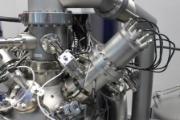
Having the newly launched Time-Of-Flight-Secondary-Ion-Mass-Spectrometer (TOF-SIMS) located just down the hallway from them in Rhodes University’s Chemistry Department makes all the difference to postgraduate students Muthumuni Managa, Gugu Kubheka and Phindile Khoza.
According to Muthumuni Managa, “We are so fortunate because all equipment’s that we need are on our finger tips. I never struggle to fully characterise my compounds because all the equipment is available. The new equipment will be beneficial because it will enable us to carry out more specific characterization that we were not able to do before,” she said.
The focus of Managa’s MSc thesis, entitled “Photodynamic antimicrobial chemotherapy activities of porphyrin- and phthalocyanine-platinum nanoparticle conjugates” includes making dyes and combining them with platinum nanoparticles as to increase their antimicrobial activities. These compounds are then embedded on fibers for support and tested for antibacterial and antifungal properties.”
The possible application for this, according to Managa, is that “if this works the possibility is that they can be put into an elastoplast and if a person has a bacterial or fungal infection on their skin they can just take the elastoplast and put it over the infections as the dyes are activated by visible light”.
Managa began her studies at Rhodes in 2007 after being accepted for a BSc foundation programme, and the choice to pursue her studies in the area of photodynamic therapy a personal one influenced by the death of her mother from cancer in 2011.
“I lost my mother to cancer and I was just about to complete my third year. I wanted to understand more about cancer and Prof Nyokong’s research group provided that for me. In my honours work I was able to do research on cancer and the current treatment and trying to combine chemotherapy and photodynamic therapy as to reduce side effects and I understood completely what my mother went through.”
Managa plans to pursue a PhD after the completion of her MSc. She believes her involvement in Science and technology could inspire other women to pursue careers in the field.
“For me this is also done to encourage girls back home in the rural village of Venda where I come from that they are able to accomplish anything they put their mind to,” she added.
Kubheka’s research focuses on the use of dyes conjugated to nanoparticles for application in antimicrobial photodynamic therapy as well as glucose sensing. Essentially, she uses bright colored dyes mixed with the nano-sized particles to kill bacterial infections.
Inspired to help increase access to medical supplies especially to rural, marginalised communities, Kubheka was drawn to chemistry after attending Professor Tebello Nyokong’s speech after being awarded the UNESCO-L'Oreal Laureate.
She also had an opportunity to work with the legendary Prof Nyokong during her Chemistry internship in her third year, working in her laboratory for a semester.
“This was when I realized that I could make a difference in solving the problem by contributing to the treatment of bacterial infections. The research that was done in this laboratory gave me that opportunity. Knowing that I am working on something that will help millions and develop our country should it be a success is very fulfilling and it gives me great pleasure and that is why I do not mind putting in more hours working in the laboratory,” she said.
The new equipment will allow Kubheka to examine surface features of the nanoparticles, for the development of sensors, depth profiling and 3D imaging of cells. “It has a positive impact on my research and on myself since I can now be compatible to using this instrument that not many other universities have, thus adding to my knowledge of different equipment,” she said.
PhD candidate Phindile Khoza’s thesis entitled “Phthalocyanine-nanoparticle conjugates for photodynamic therapy of cancer and phototransformation of organic pollutants” entails combining dyes (phthalocyanine) with nanoparticles and molecules, such as folic acid, that cancer cells require in excess. The ultimate goal is to increase the selectivity of these dyes towards tumor cells. She also also focused on the use of these dyes in pollutants removal in water.
According to Khoza, the nanotechnology equipment at students’ disposal at Rhodes “are an absolute privilege. They have definitely impacted on my research tremendously, they have made it stronger.
“I have learnt how to use and interpret data from so many techniques which I consider the biggest honour as I have seen how in other institutions they suffer, research wise, due to a lack of proper equipment,” she said.
Photo: Newly launched equipment Time-Of-Flight-Secondary-Ion-Mass-Spectrometer (TOF-SIMS).
